Famous Tree House That Art B Conkwright Lived in Ca
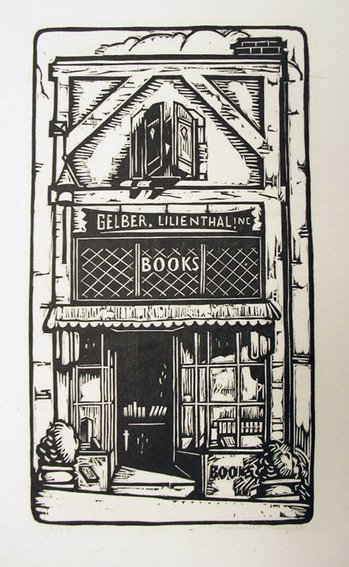
Valenti Angelo (1897-1982), Gelber, Lilienthal Inc. Books, [1920s]. Woodcut. 19/fifty. Graphic Arts GA 2007.03742.
In 1924, antiquarian Leon Gelber joined with businessman Theodore Max Lilienthal (1893-1972) to establish the Gelber-Lilienthal Book Store at 336 Sutter Street in San Francisco. As recalled by James Hart in Rare Volume Stores in San Francisco Fifty Years Ago, "That shop…was given character past an ingenious imitation front of a manufactured advent, a pseudo half-timbered edifice with a projecting shingled and slanting roof … A small hallway led to a lofty ceiling, in old-English style and great rows of shelves for rare books. …They were two attractive, charming, and witty men, quite without the pressure level of salesmanship …."
The partners also established a publishing visitor nether the banner Lantern Printing. Many of their editions were printed at Grabhorn Press, beginning with Hildegard Flanner's A Tree in Flower and Other Verses (1924). Graphic Arts Collection (GAX) PS3511.L28 T7 1924.
It was the Grabhorn Brothers who first introduced them to the illustrator and printmaker Valenti Angelo (1897-1982). Angelo moved to San Francisco when he was nineteen-years-old and x years later, began cutting and printing volume plates. In 1927, Angelo illustrated For Whispers & Chants by Jake Zeitlin, printed by Grabhorn Printing and published by Lantern Printing (Graphic Arts GAX 2007-1271N).
Throughout his long career, Angelo illustrated roughly 250 books, of which Princeton owns fifty-four. Above is his woodcut of the Gelber-Lilienthal Shop.
See more: Valenti Angelo: Author, Illustrator, Printer (San Francisco: Book Club of California, 1976). Rare Books (Ex) Oversize Z8036.483 .V34qr
Come across also: Robinson Jeffers (1887-1962), Theodore Max Lilienthal ([San Francisco: F. B. Lilienthal, Grabhorn Printing], 1953).
Special thanks to Alastair Johnston of Poltroon Printing for his aid researching this mail. http://www.poltroonpress.com/most.html
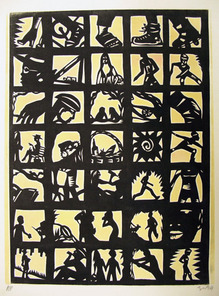
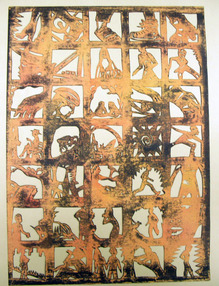
Beatrice Coron, Central Park Story, 1994. Pochoir print and stencil. Graphic Arts GA 2007.02453 and 02452. Gift of Beatrice Coron.
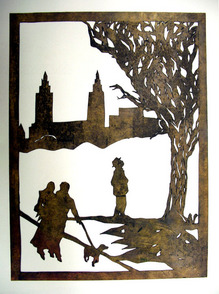
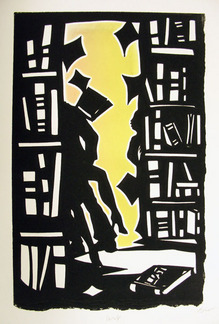
left: Beatrice Coron, Last Leaf of Fundamental Park, 1990s. Stencil for pochoir print. Graphic Arts GA 2007.02453. Gift of Beatrice Coron.
right: Beatrice Coron, Animalism, 1990s. Pochoir print. Graphic Arts FA 2007.02455. Gift of Beatrice Coron.
Over x years agone, Graphic Arts was the fortunate recipient of a souvenir of art from the French paper architect Beatrice Coron, who has been living in New York Metropolis since 1984. Those who have ridden the subways in New York will recognize her blackness newspaper work from the affiche "All Effectually Boondocks" featured in the cars of the E, F, and half-dozen trains.
Her website http://www.beatricecoron.com offers additional images besides as a personal argument, which begins: "My work tells stories. I invent situations, cities and worlds. These compositions include memories, associations of words, ideas, observations and thoughts that unfold in improbable juxtapositions. These invented worlds accept their own logic and patterns. Images are conveyed through words, whether automatic writing or premeditated scenes. My creative inspiration comes from a text, a verse form, the news or from a philosophical concept that can be reduced to a mere title. I research collective memories and myths, questioning the notions of identity and belonging. For each theme, I explore various narratives: one story leads to the next, and the creation process weaves different layers of our relations to the world."
Beatrice Coron will teach a class in paper cutting at the Heart for Volume Arts on March 26-27, 2011. For information, run across: http://www.centerforbookarts.org/
Exist conscientious what yous throw away after the holidays, it might be a great work of art. Here are some we take kept.
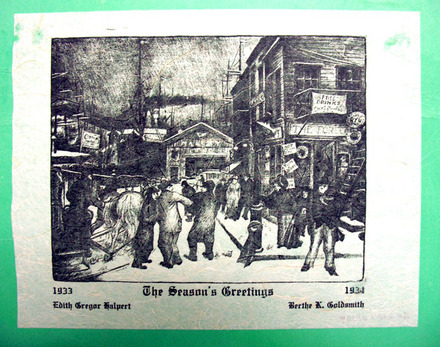
Glenn O. Coleman (1887-1932), The Season'due south Greetings, 1933. Lithograph. Graphic Arts GA 2007.01009.
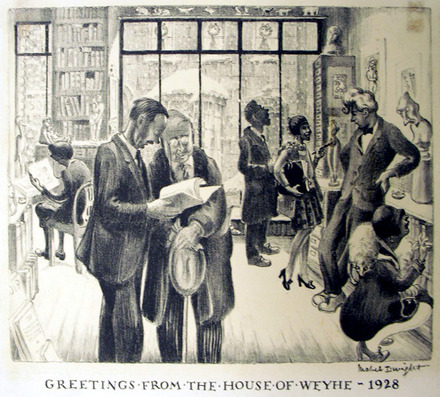
Mabel Dwight (1876-1955), Greetings from the House of Weyhe, 1928. Lithograph. Graphic Arts GA 2007.01212. Interior of Weyhe gallery in New York City with its manager Carl Zigrosser.
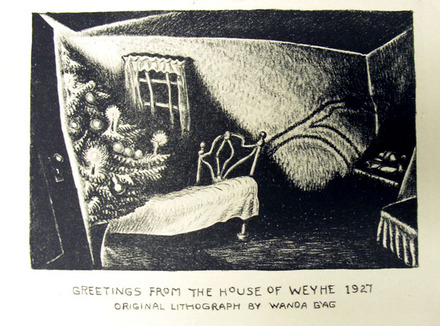
Wanda Gag (1893-1946), Greetings from the House of Weyhe, 1927. Lithograph. Graphic Arts GA 2007.01313.
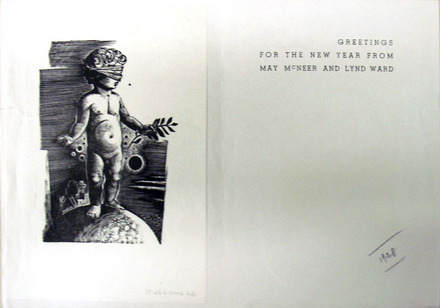
Lynd Ward (1905-1985), Greetings for the New Year from May McNeer and Lynd Ward, 1948. Woodcut. Graphic Arts GA 2007.02671.
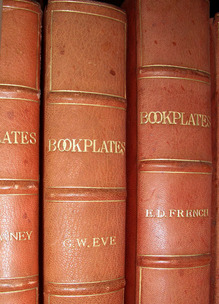
Clifford Nickels Carver (1891-1965), Princeton Class of 1913, served as secretary (1914-1915) to Walter H. Page, the American ambassador in London, as secretary (1915) to Edward Mandell House in Europe, and as assistant to Bernard 1000. Baruch working for the War Industries Lath, and to his commission in the U.S. Navy fastened to the Function of Naval Intelligence (1917-1918). His papers in the Mudd Library annal (MC010) also highlight another facet of Carver's interests, that of bookplate collecting.
His papers include bookplates by well-known Americans, Princetonians, and Europeans, with related correspondence and articles including "Modernistic American Book-plates" and "Three Victorian Book-plates." We recently discovered 9 additional leather bound volumes, each one dedicated to a single bookplate engraver with individual examples Carver trimmed and glued i per page. These volumes are on their fashion to MC010, where they will join the others in Carver'due south archive.
Here are a few examples, beginning of Carver's own bookplate and then, several from the volume defended to Charles William Sherborn (1831-1912), who specialized in heraldic designs.
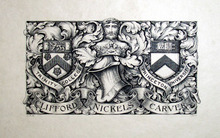
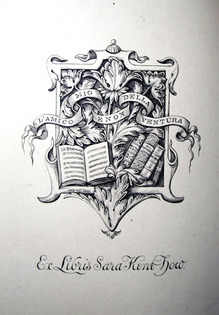
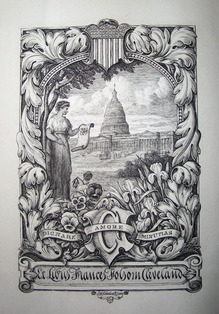
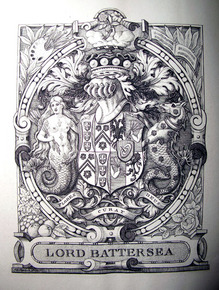
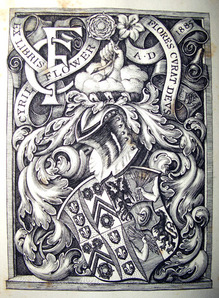
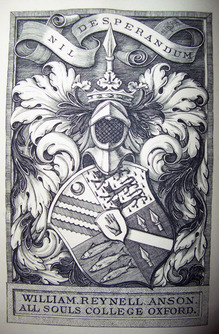
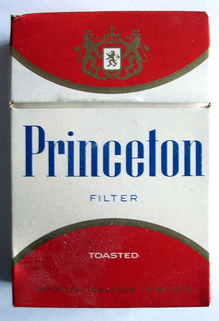
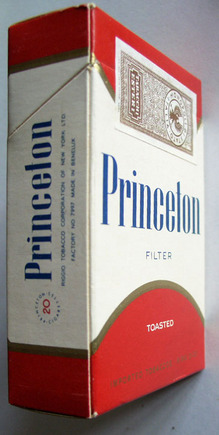
Within GC149 Ephemera, graphic arts has a small collection of cigarette packages. Some are full and some are not. I call back it would be a nice new years resolution for y'all to stop smoking and instead, transport your cigarette packages to the drove at Princeton University. Make clean, dry candy packaging and wine labels are too appreciated.
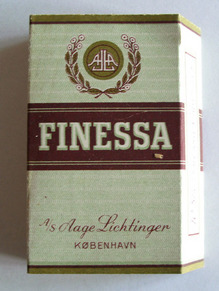
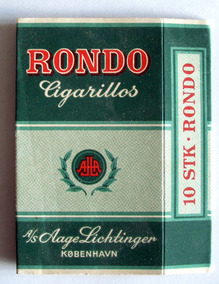
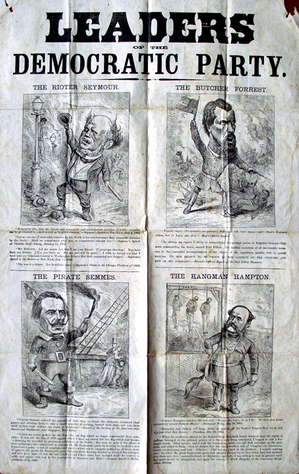
Bernard Reilly, in his catalogue American Political Prints, 1766-1876, describes this Thomas Nast broadside as "a searing, election-year indictment of four prominent figures in the democratic political party." He continues:
"Erstwhile New York governor and autonomous presidential nominee Horatio Seymour is portrayed as a 'rioter.' Continuing in a burning urban center, he waves his hat in the air while he steps on the back of a crawling effigy. In the background a corpse hangs from a lamppost. Between 1862 and 1964 Seymour had opposed Lincoln'due south was policies, and he was branded equally instigator of the 1863 New York draft riots."
"Tennessee general Nathan Bedford Forrest, the founder of the Ku Klux Klan, and infamous for his role in the massacre of surrendered Union troops at Fort Pillow, is chosen 'The Butcher Forrest.' He waves a flag labeled 'No Quarter' and fires a pistol."
"Confederate Admiral Raphael Semmes is portrayed as a pirate, wielding a knife in ane mitt and holding a flaming torch in the other … . Semmes was the scourge of Union shipping during the Ceremonious War. Under his command the Alabama, a British-congenital ship, captured threescore-two merchant vessels, near of which were burned. An excerpt from Semmes'southward July 1868 speech at Mobile, Alabama, appears beneath this image."
"Confederate cavalry officeholder Wade Hampton appears as a hangman. He holds his plumed lid at his side and wears inscribed 'C.Southward.A.' (Confederate States of America). In the distance three Yankee soldiers hang from a gallows."
Thomas Nast (1840-1902), Leaders of the Democratic Party, 1868. 38 x 24 inches (96 ten 61 cm). Forest engraved broadside. Graphic arts GA2010- in process.
Bernard Reilly, American Political Prints, 1766-1876 (Boston, Mass.: M.K. Hall, 1991). Graphic Arts Collection (GA) Oversize E183.iii .R45 1991q.
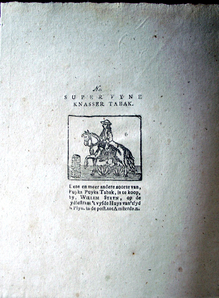
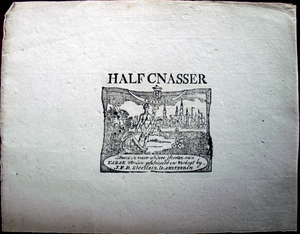
"Tobacco was among the first commodities to exist sold in printed paper wrappers," writes Michael Twyman, in his Enclyclopedia of Ephemera.
"The blueprint element of tobacco papers was normally bars to the centre of the printed sheet, which was large enough to accommodate varying quantities of tobacco. The earliest designs were in the tradition of the bookplate, but subsequently they took on the characteristics of the merchandise card and were often printed from plates actually designed as trade cards. Engraved pictorial designs were common in Deutschland, Kingdom of the netherlands, and France; although almost everywhere they gave manner to the crude woodcuts that were to remain the mutual denominator…."
Here are three recently acquired nineteenth-century examples from Amsterdam.
Maurice Rickards, The Encyclopedia of Ephemera; edited and completed past Michael Twyman, with the assistance of Emerge De Beaumont and Amoret Tanner (New York: Routledge, 2000). Graphic Arts: Reference Drove (GARF), Oversize NC1280 .R52 2000q
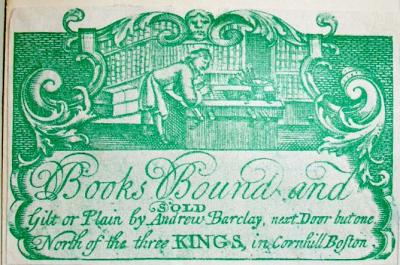
In 2009, Ms. Jan Lilly graciously donated a collection of bookseller and bookbinder tickets to the graphic arts collection. They came with boggling provenance, being the collection of P.J. Conkwright (1905-1986). Ms. Lilly told us that
"many from books being rebound by Earl Smith—head of handbindery at PUP [Princeton University Printing]—years agone. They used to bind things—and rebind—for the university."
Some, like this one, are reproductions of the original. Some are originals. Perhaps Conkwright made a copy and put the original back? The ones he kept were glued to an index carte du jour and filed occording to city and occupation.
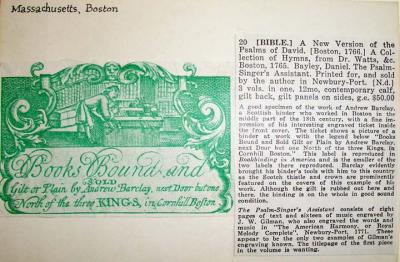
"P. J. Conkwright came to the Princeton Academy Printing in 1939 from the Academy of Oklahoma, from which he had received a masters degree and at whose press he had worked as a book designer. In the following decades, his work as a typographer and book designer became nationally known, particularly in the almanac exhibitions of the best fifty books produced in the U.South. held by the American Institute of Graphic Art. Many of the books he designed were honored there, and in 1955 the AIGA awarded him its gold medal. Perhaps the best known work credited to his skills is the multi-volume ready of the Jefferson papers, which the Press began issuing in 1950". From Princeton's Conkwright finding assist.
For more information on this ticket of Andrew Barclay in detail, run into Hannah D. French, "The Amazing Career of Andrew Barclay, Scottish Bookbinder, of. Boston," Studies in Bibliography Fourteen (1961): 143-62. Information technology's onlne at http://etext.virginia.edu/bsuva/sb/. Click on 14, on the left, and you'll see information technology in the contents list.
In 1897, the Aldershot Cottage Hospital (approximately 30-five miles from London) finally opened with beds for ten patients. Every fall, the boondocks of Aldershot had been holding a carnival or park fête to raise money in club to build a hospital. Special fabric programs and issues of the Aldershot newspaper were printed on colorful silk/satin and sold every bit souvenirs. Several of these from the first and second carnivals take been acquired by graphic arts. Note the advertisement on the front page for a typewriter offer visible writing.
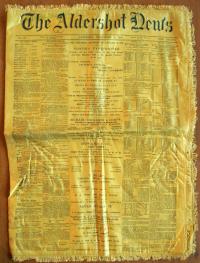
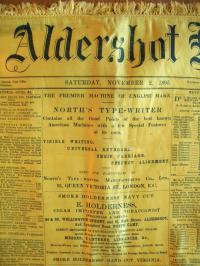
The Aldershot News. No. 72, Sabbatum, Nov two, 1895 (Aldershot: printed and published by the Proprietors, Gale and Polden, Ltd., Wellington Works, 1895). Printed on yellow silk. Graphic Arts (GAX) 2010- in process.
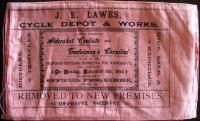

The First Aldershot Cyclists and Tradesmen's Funfair in Help of the Proposed Cottage Hospital for Aldershot … November fifth, 1894. Official programme. x leaves printed on pinkish silk. Graphic Arts (GAX) 2010- in process.
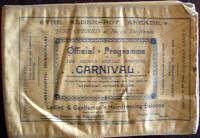
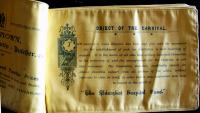
Official Plan of the Second Annual Hospital Carnival … Wed, Oct 30, 1895. (Aldershot: J. May, Steam Printer, 1895). 10 leaves printed on xanthous silk. Graphic Arts (GAX) 2010- in process.
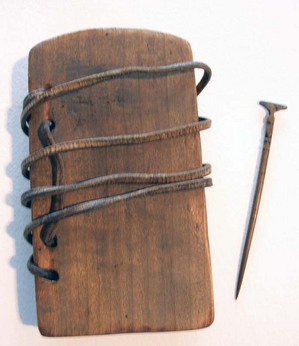
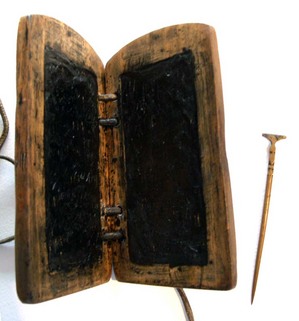
"A diptych is a sort of notebook, formed by the union of two tablets, placed i upon the other and united by rings or by a hinge. These tablets were made of wood, ivory, bone, or metallic. Their inner surfaces had ordinarily a raised frame and were covered with wax, upon which characters were scratched by means of a stylus. Diptychs were known amidst the Greeks from the sixth century before Christ. They served as copy-books for the practise of penmanship, for correspondence, and various other uses". (See the Cosmic Encyclopedia entry: [http://www.newadvent.org/cathen/05022a.htm])
Wax coated tablets (either singularly or in spring diptyches) provided an cheap, portable, and reusable writing surface. Today, nosotros say "start with a clean slate," afterward the clerics who would clear the wax surface of their tablets using the apartment superlative of the writing stylus.
The wood diptych and bronze stylus in graphic arts measures 9.5 ten 17 x ix.5 x 2 cm with four holes in each tablet spring together with a leather strap. It is assumed that our get-go curator, Elmer Adler, had this fabricated for teaching.
For more on the history of writing, encounter Bernhard Bischoff (died 1991), Latin Palaeography: Antiquity and the Center Ages (Cambridge; New York: Cambridge University Press, 1990). Firestone Z114 .B5713 1990
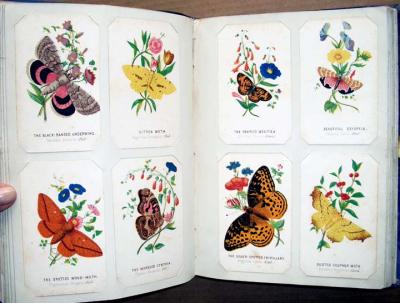
Between 1864 and 1876, the American printmaker Louis Prang (born in Poland, 1824-1909) issued a series of collectable albums, offer examples of his company's brilliant chromolithographs, or Prang's Chromos, as they were called. The cards were issued in sets of twelve, presented together on double folio spreads as seen here. This anthology contains twelve scenes each of the Hudson River, Central Park, birds, ferns and mosses, leaves, roses, butterflies, fruit blossoms, wild flowers, and pansies.
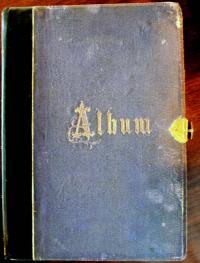
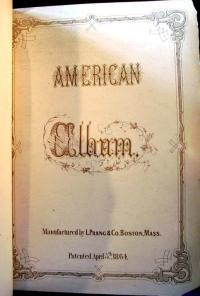

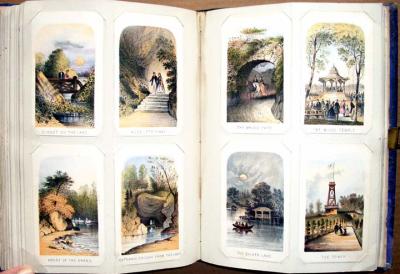
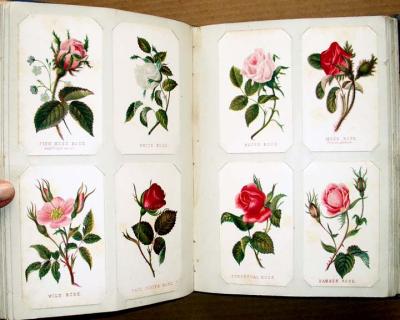
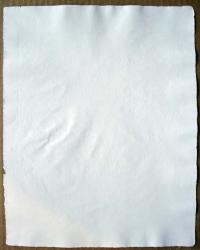
This canvas of handmade newspaper comes from the Fabriano Paper Mill in Milan. In regular light, it looks like a blank canvas merely when you lot hold it to the light, the watermark becomes visible. The image, which is a reproduction of Gentile da Fabriano'south "Coronation of the Virgin," comes from the variations in thinness or thickness in the paper.
The watermark begins with the Italian artisan Annarita Librari etching the engraving in wax; a process that may accept from v months to a year to complete. Copper dies (positive & negative) are made from the wax sculpture. The dies are pressed into a contumely screen, which volition form the papermaking mould. Then, tiny wads of screen must be blimp and stitched invisibly into the mould as reinforcements in all the cavities, such as the forehead or cheeks.
Nosotros are fortunate to have acquired two examples of Ms. Librari'due south work, one of which is seen here. To see Gentile da Fabriano's original tempera and gold leaf panel, see: http://world wide web.getty.edu/art/gettyguide/artObjectDetails?artobj=736
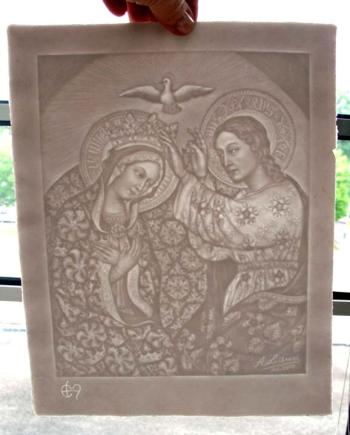
Calorie-free-and-shade watermark depicting the "Coronation of the Virgin" by the Renaissance painter Gentile da Fabriano (Milan, Fabriano Paper Mill, 2006). Graphic Arts GAX 2010- in procedure.
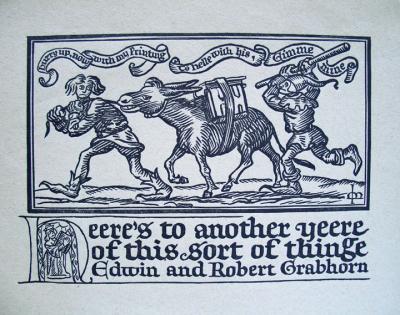
This new years menu turned up in our collection of fine printing and ephemera from Grabhorn Press. Notation the text: Hurry upwards now with my Printing. To helle with his, Gimme mine. Heere'south to another yeere of this sort of thinge.
The Grabhorns—Edwin, Robert, Jane, and Mary—moved from Indianapolis to San Francisco in 1919 where they renamed their printing shop "Grabhorn Printing". They produced a broad variety of materials, including limited edition books, pamphlets, cards, and whatsoever other blazon of letterpress press their customers ordered. The most famous project may have been a handset edition of Walt Whitman's Leaves of Grass, published past Random Firm in 1930 (Graphic Arts GAX Oversize 2007-0343Q). Grabhorn Press officially closed in 1965.
Fine Press Press Ephemera Collection, 1898-2010 (bulk 1924-1948): Finding Assist GC186, Box 2. From the Grabhorn Printing drove of Myles Standish Slocum, class of 1909, presented by Isabel Shaw Slocum.
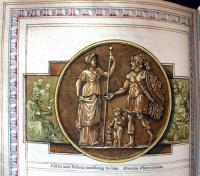
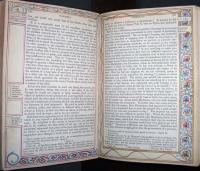
These are pages from a reprint of the Roman part of the History and Biography section of the Encyclopaedia Metropolitana, published in Glasgow 1853. A dry volume? This copy has been carefully decorated past a reader in the early twentieth century with original borders and illustrations on more than l of its pages.
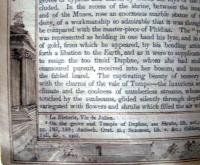

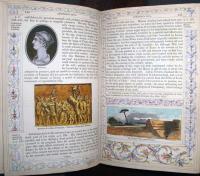
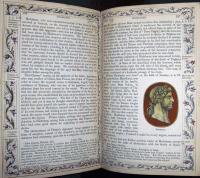
Encyclopaedia Metropolitana or System of Universal Knowledge... (Glasgow: Richard Griffin and Co., 1853). Graphic Arts GAX 2010 -in procedure.
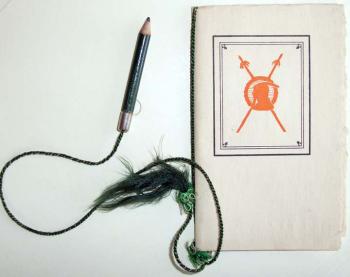
Here are a few examples of nineteenth- and early twentieth-century dance cards from our ephemera collection.
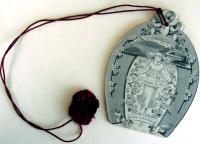
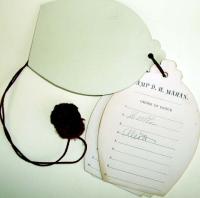
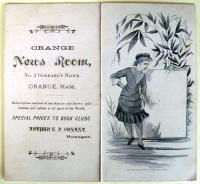
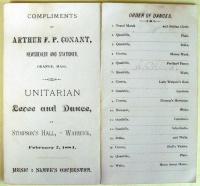
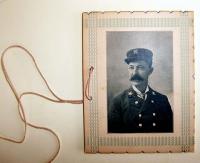
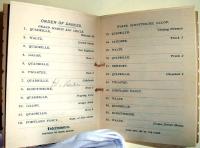
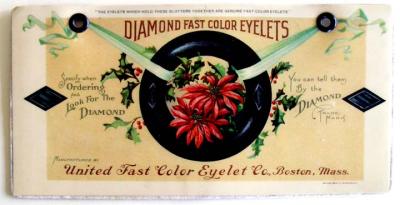
Many years ago, when writing was done with a pen and liquid ink, soft sheets of unsized paper were used to blot the excess ink from the folio. During the nineteenth century, the ubiquitous blotter packet was quickly recognized as an advertising opportunity for local companies. Michael Twyman writes "The advertising blotter, effectively a desk-top trade carte and twelvemonth-round promotion slice, remained in general apply until the appearance of the ball point pen, which in the period 1945 to 1960 progressively replaced the steel rib and liquid inks" (Encyclopedia of Ephemera, 2000).
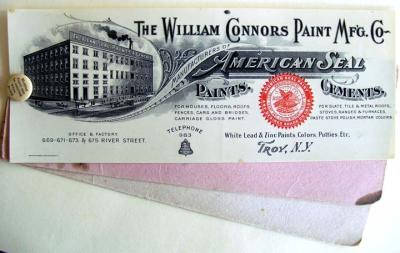
Early blotting newspaper was grey and coarse merely during the nineteenth century, a college quality paper was used in a variety of colors. Pink was most mutual due to the use of turkey and cotton wool rags, which resisted bleaching. Queen Victoria is said to have used a red blotting paper but nosotros don't know for sure because each sail was carefully destroyed. Graphic Arts, Ephemera Collection.
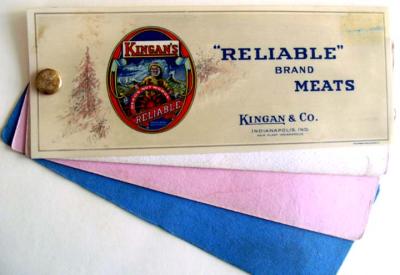

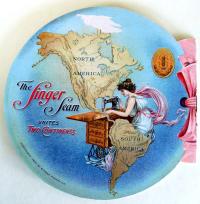
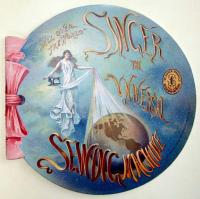
All Over the World: Vocalist, the Universal Sewing Motorcar (New York?: Singer Manfg Co., 1901). Graphic Arts GC149 Ephemera Collection, Booklets
For the Pan-American Exposition of 1901 in Buffalo, New York, the Singer Manufacturing Company printed this eight folio booklet to advertise their products. Scenes from the Globe'south Fair were interspersed with vignettes featuring sewing machines. Here are a few of the photo-lithographed pages.
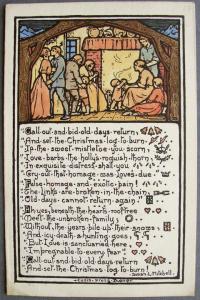
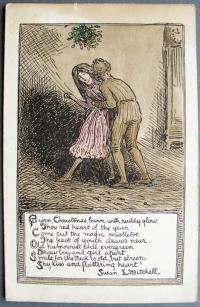
In 1902, the Irish carpet designer Evelyn Gleeson (1855-1944) wrote to Elizabeth Yeats (1868-1940) and her sister Lily (1866-1949) in London. She persuaded them to return to Dublin and join her new women's craft cooperative. Evelyn taught girls to weave tapestries and rugs, Lily oversaw embroidery, and Elizabeth established a fine press. They named information technology the Dun Emer Gild, after the nearby village of Dundrum.
Elizabeth's first volume was a collection of poems by her blood brother, William Butler Yeats, entitled In the Seven Woods. West.B. wrote an introduction mentioning that the book was "finished the sixteenth day of July, in the twelvemonth of the big wind, 1903."
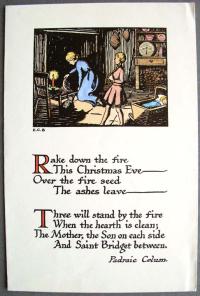
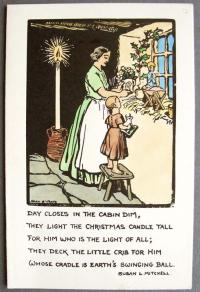
When James Joyce wrote Ulysses (1920), he commented on the Yeats family business and the weird sisters:
Haines sat downwards to pour out the tea.
—I'g giving you lot two lumps each, he said. But, I say, Mulligan, y'all do make potent tea, don't you?
Buck Mulligan, hewing thick slices from the loaf, said in an old adult female's wheedling vocalisation:
—When I makes tea I makes tea, as old mother Grogan said. And when I makes water I makes water.
—By Jove, it is tea, Haines said.
Buck Mulligan went on hewing and wheedling:
—SO I Practice, MRS CAHILL, says she. BEGOB, MA'AM, says Mrs Cahill, GOD Transport YOU DON'T Brand THEM IN THE One POT.
He lunged towards his messmates in plough a thick slice of bread, impaled on his knife.
—That's folk, he said very earnestly, for your book, Haines. 5 lines of text and ten pages of notes nigh the folk and the fishgods of Dundrum. Printed by the weird sisters in the year of the big wind.
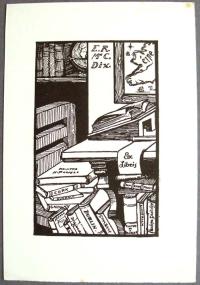
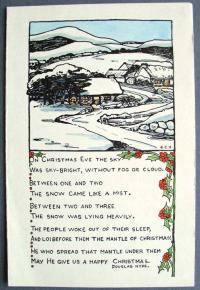
The Yeats sisters eventually split from Gleeson, renaming their operation Cuala Press (pronounced Cool-a), which continued until 1946. Besides the books, Cuala likewise printed ephemera including Christmas cards, Easter cards, bookplates, calling cards and broadsides. These are a few examples from graphic arts drove.
For more than data, attempt Boston College's website: http://www.bc.edu/libraries/newsletter/2008fall/cuala/alphabetize.html ;
Gifford Lewis, The Yeats Sisters and the Cuala (Blackrock, Co. Dublin: Irish gaelic Academic Press, 1994). Firestone Library Z232.C962 L49 1994
and the RBSC exhibition Unseen Hands: Women Printers Binders and Book Designers: http://infoshare1.princeton.edu/rbsc2/ga/unseenhands/printers/yeats.html
Source: https://www.princeton.edu/~graphicarts/ephemera/index5.html